Hinesburg Fall Festival draws a crowd Page 2

Sweeps week
Girls take top spot at track meet, alum honored Page 10


Hinesburg Fall Festival draws a crowd Page 2

Girls take top spot at track meet, alum honored Page 10

A new designation in the Hinesburg would give a financial boost to a proposed development offering up to 60 affordable homes, officials say, but skeptics worry about the implications, particularly regarding possible Act 250 exemptions.
Alex Weinhagen, Hinesburg’s planning and zoning director, this month asked the selectboard to approve an application for a Neighborhood Development Area designation for the town’s village — 40 square miles of land off Route 116 wedged between the LaPlatte River and Patrick Brook that for years has been queued up for development.
Roughly 400 units of residential housing are planned for the area, including developments like Haystack Crossing, Hinesburg Center II, Kelley’s Field and others.
“The designation program is something that communities across the state leverage to help their communities install infrastructure and help achieve their goals,” Weinhagen said. “It doesn’t sound prudent for Hinesburg to not pull that lever. It’s something that’s available to us.”
The state-offered designation
provides a variety of benefits for both the town and property owners looking to develop land, including priority in grant funding for things like new sidewalks and bike paths; a reduction in state wastewater permitting fees; financing priority for affordable housing projects; and tax credits for the improvement of building facades or other code improvements, Weinhagen said.
While the designation would have a wide range of benefits for stakeholders in the area, the designation was a specific ask of developers of the Windy Ridge project, a new affordable housing project on the land around the NRG systems facility.
That project, first announced in March 2022, would bring 75 homes to land just south of the Champlain Union High School in the village. Sixty units will be perpetually affordable to households earning less than 100 percent of area median income.
The 46 acres of land was donated by Jan Blomstrann, the founder and former owner of the energy firm NRG Systems and will be developed through a partnership with the Champlain Housing Trust. Officials estimated the project
See HINESBURG on page 13
Charlotte’s new town administrator is set to take the reins Oct. 2, an undertaking he said he has been preparing for most of his life.
Nathaniel Bareham, originally
from New York, has spent more than two years in the Green Mountain State studying environmental law at the Vermont Law and Graduate School where he says his passion for law and local government came together.
“I actually came across a
couple of articles that were written by some of the clinics at Vermont Law School pertaining to land use,” he said. “I was doing a little bit of work with the Finger Lakes Land Trust and I hopped online, checked out the school and absolutely loved it. I applied and was
accepted, didn’t look back and moved up to Vermont.”
Prior to this time, he was working in the New York state park system as a water safety coordinator, a program he managed for just under three years handling the administrative side of things while

also being the designated point person to mediate any problems.
“It was a fairly large and substantial program,” he said. “We had a staff of about 70 that was
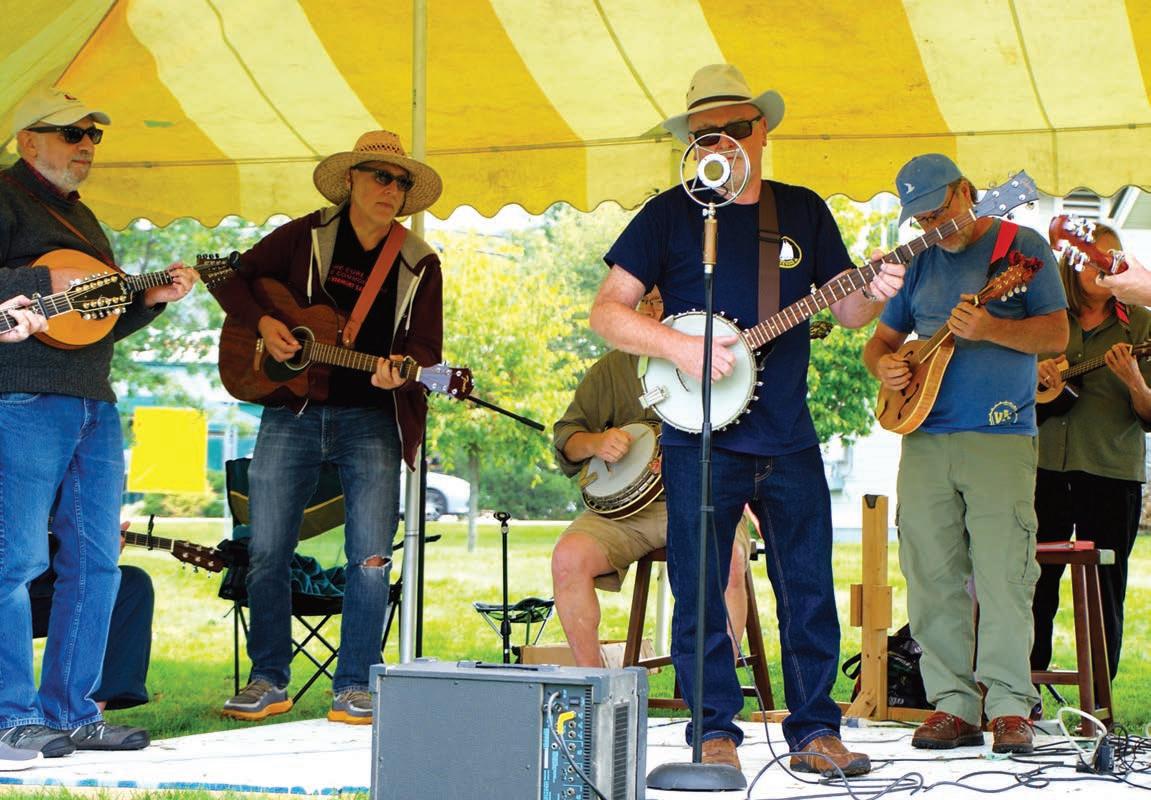
The sun peeked through the clouds onto the grassy field by the Hinesburg Town Hall Saturday as Maggie Gordon introduced guests to the new town common.
“As many people know,” Gordon said, “Hinesburg has no public gathering space, and this is going to be it.”
Gordon was welcoming folks to this year’s festival last week, which she helped organize. The festival has been going on for the past 17 years on and off in various locations, but with construction of a park on the space about to get underway, the event will soon have a permanent home.
Hinesburg locals flooded the space with kids and dogs, taking advantage of activities like old-timey apple pressing, a puppet show and local food offerings.
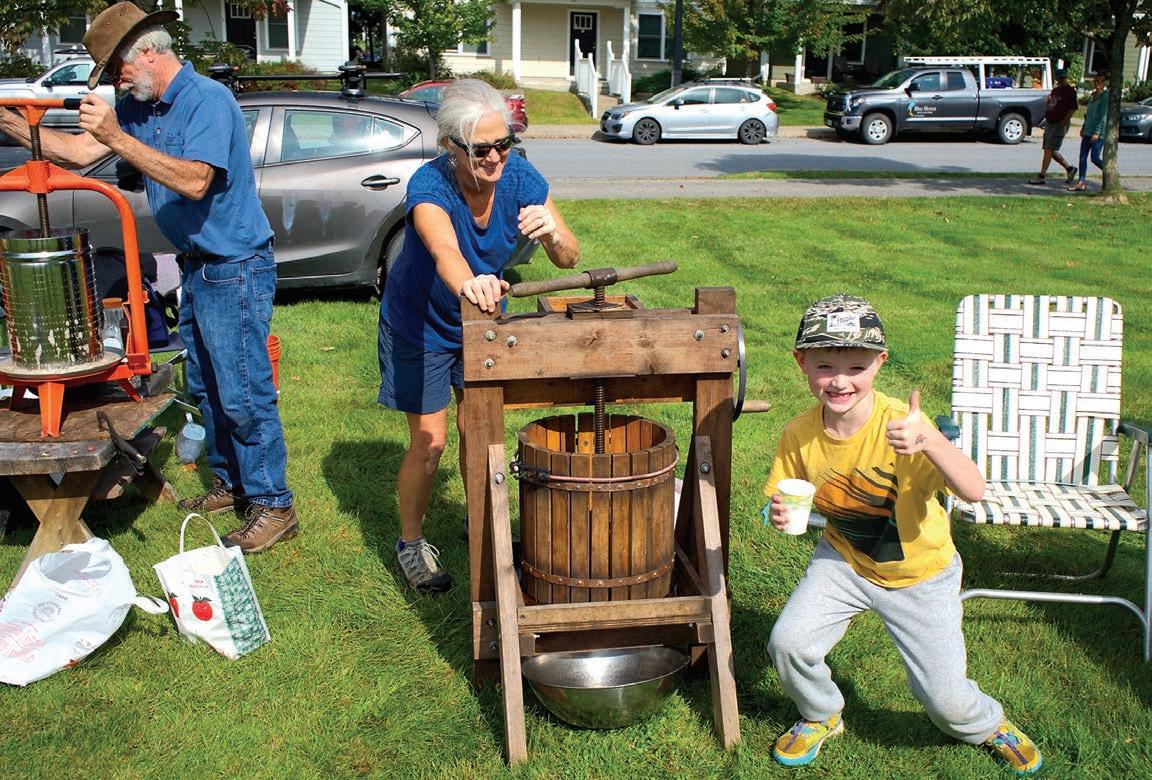
Linda Segovia Wise and Amanda Segovia Bradley watched their kids in the corn pit laughing along at the hilarity of dry corn being stuffed down their shirts.
“It makes me emotional how special Vermont is and how special this community is,” Bradley said.
Asked why she was attending the event, her eyes welled. “In a simple way, it doesn’t matter if you’re on a budget or not on one, you can come and enjoy the beautiful weather and the people.”
Out-of-towners seemed to sense the feeling of the day, too.
Steve Fox, visiting from Oregon, said he can sense that feeling of hometown coziness while waiting for food outside the Las Hermosas food truck. Pat Kelleher traveled from Cork, Ireland, to play with the Hinesburg SongFarmers, the local chapter of a movement to start jam sessions in communities around the world.
He and Hinesburg musician Rik Palieri, a founding member of the town’s SongFarmers group, have been in contact for years, but this was the first time they were able to play together in person, and what a better venue than the original location of the Front Porch Music Association, which started SongFarmers.
Musical performances kicked off with a student band, the Hinesburg Community School GreenHawks, led by music teacher Niel Maurer.
Next was a band from the University of Vermont, Flint and Steale, serenading the audience with variations of covers and original folk songs.
“Good things are worth waiting for,” Palieri said as he introduced the final musical act of the day: himself, Kelleher and the SongFarmers.
Dozens of locals, including Bruce Jameson, gathered, as they do on the first Thursday of every month at the Carpenter-Carse Library, to participate in the joy of making music.
The final event of the day was the annual Stone Soup dinner. All day a curious pot over a little fire was getting fuller and fuller. Andrea Morgante, and a member of the Hinesburg Land Trust, was gathering food from local farms and gardens for a European folktale-inspired soup.


A 17-year-old who “threateningly displayed” a BB gun during a varsity football game at Champlain Valley Union High School Saturday was cited for possessing a dangerous weapon on school property and for giving police false information.
The juvenile, a male from Hinesburg and a former CVU student, was reportedly showing the weapon to people and pointed it at least one person, according to Hinesburg police chief Anthony Cambridge.
“He was showing it to people, lifting his waistband. You could not tell the difference — unless you really knew guns — if it was a
real gun or not,” Cambridge said.

Several students in the audience saw the gun and notified an administrator on duty who called the Hinesburg police, according to a letter district superintendent Rene Sanchez sent to parents and other members of the district.
“The police responded immediately and ensured the safety of those attending the event,” Sanchez said.
Police arrived on scene and found the juvenile, who told police he didn’t have a weapon. Officers later found the gun in a backpack.
Police issued the juvenile a trespass notice to stay off school grounds and was then taken to the Hinesburg Police Department, Cambridge said, and later released
to a family member.
He was cited with possession of a dangerous weapon on school property and giving false information to police.
The incident remains under investigation, and Cambridge said the juvenile could possibly face a charge of criminal threatening.
Sanchez, in the district-wide letter, said mental health staff will be available for students upon their return to school.
“We know that a traumatic event such as this can elicit a variety of reactions from our young people,” Sanchez said, adding that “all CVU parents and caregivers will receive a separate message from principal (Adam) Bunting sharing pertinent information as it arises.”
The Vermont Public Utility Commission is seeking applications for membership on two advisory groups to help design Vermont’s potential clean heat standard program.
The commission will appoint members of the public and representatives of various organizations to serve on either its Technical Advisory Group or the Equity Advisory Group.
The Affordable Heat Act, or Act 18, directs the commission to reduce greenhouse gas emissions


in Vermont’s heating-fuel sector and to design a regulatory structure based on clean heat credits.
The technical group will assist the commission in designing the ongoing management of the program and in developing the accounting methodology and values for clean heat credits and measures.
The mission of the equity group is to ensure that an equitable share of clean heat measures is delivered to low- and moderate-income Vermonters and that heating fuel
remains affordable.

Send letters of interest to puc. businessmanager@vermont.gov or by mail to Business Manager, Vermont Public Utility Commission, 4th Floor, 112 State St., Montpelier VT 05620-2701 by Oct. 9.

Letters of interest should identify the advisory group on which the applicant seeks to serve; identify the entities or relevant groups, interests and expertise they seek to represent; describe their qualifications; and explain their reasons for wanting to serve.
Total incidents: 25
Arrests: 1
Traffic Stops: 8
Sept. 19 at 7:24 p.m., officers responded to a domestic dispute on Buck Hill Road East. Howard Popke, 68 of Hinesburg, was arrested for aggravated domestic assault with a deadly weapon.
Sept. 21 at 10:09 a.m., officers trespassed an individual from a residence on North Road at the request of the homeowner.
Sept. 21 at 2:37 p.m., a person was assisted with fingerprinting for employment purposes.




Sept. 21 at 3:02 p.m., a motorist was assisted on Route 116 with a disabled vehicle.
Sept. 21 at 4:03 p.m., an officer assisted first responders with a medical emergency on Texas Hill Road.
Advertising Wendy Ewing wendy@shelburnenews.com (802) 985-3091 x12
Advertising Director Judy Kearns judy@otherpapersbvt.com (802) 864-6670 x21



News Editor Tommy Gardner
Staff Writers Aaron Calvin Corey McDonald Liberty Darr
Production Manager Stephanie Manning stephanie@shelburnenews.com
Editor/Publisher Gregory Popa gpopa@stowereporter.com




Sept. 21 at 6:58 p.m., officers investigated a theft of property from a business on Commerce Street.
Sept. 23 at 6:43 p.m., officers responded to Champlain Valley Union High School after a former student brandished a BB gun on school grounds. That investigation is still ongoing. (See related story, page 3)

Sept. 25 at 3:15 p.m., a welfare check was conducted off North Road.
Sept. 25 at 6:50 p.m., an officer assisted first responders with a medical emergency on Patricia’s Place.
Note: Charges filed by police are subject to review by the Chittenden County State’s Attorney Office and can be amended or dropped.

Billing inquiries Leslie Lafountain leslie@stowereporter.com (802) 253-2101



Advertising submission deadline: Friday at 5 p.m. advertising@thecitizenvt.com classifieds@thecitizenvt.com
Editorial submission deadline: Friday at 5 p.m. news@thecitizenvt.com
Calendar submission deadline: Friday at 12 p.m. news@thecitizenvt.com
Contact: 1340 Williston Road South Burlington, VT 05403 (802) 985-3091

Family Center of

members and businesses can drop diapers off at the Community Outreach Building during regular business, 383 Sherwood Drive in Montpelier. The diaper bank distributed over 19,939 diapers to 216 children in need, and 10,384 diapers to eight community partners. From right, Charity Clark, attorney general of Vermont, drops off diapers at the center’s diaper bank with Claire Kendall, its co-executive director.

We are currently facing the impacts of climate change. The heavy rainfall and flooding that occurred during the summer resulted in a significant amount of contaminants and sediment flowing into lakes and rivers.
Nevertheless, the contamination could have been much worse, as highlighted by Oliver Pierson in VTDigger, who said that “a decade’s worth of effort” made watershed infrastructure more resilient to flooding and climate change impacts.
However, there is still much more work to be done. To prepare for such heavy rainfall occurring in the future, we must not only continue this work, but we must accelerate it.
The focus on flood resilience often revolves around hard infrastructure such as roads, bridges and wastewater systems. These are large projects that require time, money and specialized skills. However, individuals can play a significant role in protecting streams and lakes from the contamination caused by the intense runoff resulting from heavy storms.
By changing how you manage your property, whether a small lot or many acres, everyone can help to mitigate some of the damage done by heavy storms, reducing runoff of sediment and pollution into waterways.
Changes that might seem small can cumulatively have a big impact.

Heavy runoff carries nutrients such as phosphorus as well as other pollutants into lakes and streams. Higher levels of phosphorus can lead to cyanobacteria blooms, fouling waters and releasing toxins. The serious and widespread blooms we have seen in Lake Champlain this summer are an example of what happens when large amounts of contaminants enter the water.
There are ways that individuals can help reduce this contamination. In fact, many of the helpful actions involve doing less work. If you own lakefront or streamside property, a simple and effective way to protect the water quality is to avoid mowing your lawn all the way to the water’s edge. This is because grass, with its shallow roots, is not effective at absorbing runoff. Heavy rains will flow across the lawn and carry pollut-
ants and sediments into the water.
By reducing lawn mowing and creating vegetated buffers at the shorelines, you can effectively absorb more runoff and reduce the contaminants that reach the water. In addition, planting native flowers, shrubs and trees, with their deeper roots, can help protect shorelines from erosion and reduce sediment and nutrients from entering the water. These plantings can also attract pollinators and birds. By mowing less, you can also enjoy more leisure time and observe the beauty of nature around you.
When lakes become flooded, the increased water levels can cause erosion to areas of the shoreline that are typically not in contact with the water. This becomes a particular problem if large waves hit the shoreline at these higher levels. Something boaters can do to help prevent erosion is to refrain from creating wakes of any size during flood conditions.
Even if your property is not on a lake or stream, you can still make a real difference. No matter how far from a water body you are, runoff from your property will find its way into streams and lakes in your watershed. By strategic plantings, addressing drainage from roofs and other impervious surfaces, proper grading of driveways and private roads and eliminating the use of fertilizers and pesticides you can help to build flood resilience and protect freshwater resources.
Looking to create a beautiful
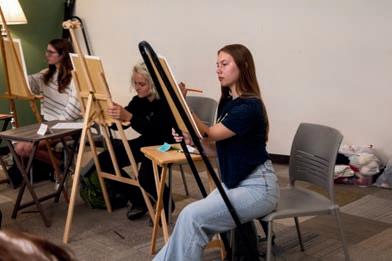
and low-maintenance landscape that can improve our state’s flood resilience while reducing your workload? Check out the Federation of Vermont Lakes and Ponds publication, “Guide to Healthy Lakes,” for ideas and landscaping plans. You can also find additional resources, including lists of native plants and more landscaping ideas. Local nurseries often carry native plants, shrubs and trees and can help with suggestions.
To the Editor: Zoning regulations are an important part of town planning. They are indispensable to Charlotte’s ongoing efforts to balance growth and development with the preservation of its natural beauty, agricultural heritage and unique sense of community. Each zoning district comes with specific bylaws to protect the character of the area and its natural resources. But what happens if residents aren’t happy when they are not allowed to do as they please?
Additionally, there are programs available that offer advice and ideas for reducing runoff. The Storm Smart program can provide helpful information about reducing rainwater runoff, while the Vermont Department of Environmental Conservation’s Lake Wise program works with lakefront property owners to protect lakeshores and develop lake-friendly landscapes.

A case in point is a controversial camp replacement application on Thompson’s Point this year. (“Selectboard approves Thompson’s Point project,” Sept. 21, 2023)
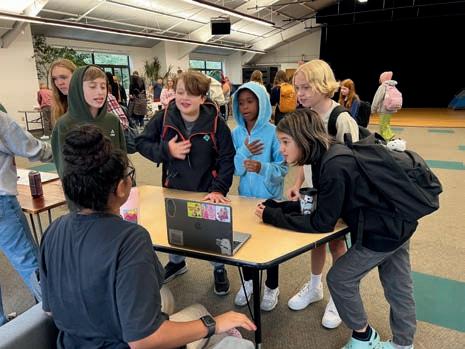

The applicants proposed to replace their old camp with a new structure more than twice its original size and in a new footprint. The location was problematic, consisting of a steep hillside covered with old growth tree species, predominantly cedar and hemlock. This part of Thompson’s Point contains a rare natural community called a limestone bluff cedar-pine forest that can
It is essential to take swift action toward creating a resilient landscape and safeguarding our precious water resources. Interestingly, doing more may sometimes require us to work less. As the fall planting season is upon us, it is an opportune time to begin implementing some changes in your landscape.
By letting native plants, shrubs, and trees thrive and decreasing mowing and fertilizer usage, we can enhance the protection of our water bodies, promote biodiversity, foster a healthier environment and enhance flood resilience.
Pat Suozzi lives in Hinesburg and is the president of the Federation of Vermont Lakes and Ponds.
only be found along Lake Champlain in Vermont. It is considered highly threatened and a conservation priority in the state.
All land on Thompson’s Point is owned by the town and leased to the camp holders. Without consideration of the ecological damage this construction would cause, the applicants had elaborate plans drawn up, managed to get approval to cut a large number of trees and obtained a state permit for shoreland protection. But their application
See LETTERS on page 6
"Every day I see my child building confidence, academic integrity, and a broader and deeper understanding of the world."
- Current Parent
It is essential to take swift action toward creating a resilient landscape and safeguarding our precious water resources.
Once again, Vermont’s future is the topic of an initiative by a high-powered collection of partners, this time under the auspices of the Vermont Chamber of Commerce.
A good case can be made that today is an apt time for another Futures report, hopefully free from interest group agendas. That’s because demographic trends, the COVID-19 pandemic, a crippling flood, billions of federal dollars, a soaring homelessness problem and the belief in a global climate emergency have put a lot of forces into motion to seek the driver’s seat for the state’s future.
Let’s look at some earlier efforts.
In 1987 Gov. Madeleine Kunin appointed a Governor’s Commission on Vermont’s Future, chaired by the former head of President Carter’s Environmental Protection Agency. This important person had settled in Vermont earlier that same year, and the governor seemed to think he was well suited to advise Vermonters on their state’s future.
Its theme was centralized control of land use to prevent private landowners from doing anything contrary to the public interest. That interest was to be defined and enforced through regulations ominously described
by Kunin as “uniform in standard, specific in requirements, and tough on delinquents.”
The Legislature passed Act 200 of 1988, but her longed-for state land controls faded away soon after passage, when 125 towns adopted resolutions condemning the scheme.
In 2006 the Ethan Allen Institute, aided by a Project Advisory Group heavy with economists and business leaders, produced a report entitled “Off the Rails: Changing Economics, Accumulating Obligations: How Will Vermont Cope with a Challenging Future?”
And now comes the Vermont Futures Project. With a board of business-friendly leaders, the project is at work to use the magic of data to define updated economic development goals.
Alas, its analysis, projections, warnings and recommendations did not appeal to legislators and others determined to extend the reach and responsibilities of state government and find some way to extract the new costs from increasingly overburdened and overregulated taxpayers.
In 2021 the federally funded Vermont Council on Rural Development held 22 rural summits around the state to learn what our communities need to do, and to stand for … to build a successful,
prosperous and unified Vermont in 2050.” It produced “The Vermont Proposition” featuring, as I wrote at the time, “what you would get if you assembled a dozen of the most high-minded, most sincere, politically correct liberals in the state, who as liberals are not at all hesitant to use the power of government to make sure everyone falls in line with the grand vision.”
“The Vermont Proposition” was the first to point to the supposed climate emergency to bolster its pleas for bold action to defeat “the existential threat of our time” that if unaddressed, “will result in catastrophic impacts on communities, states and ultimately on world civilization.”
Its leading proposal was carbon pricing, better known as a carbon tax, to generate a huge revenue flow to subsidize favored people and enterprises waging war against climate change.
In December 2021 the Vermont Climate Council, a government within the government, released its Climate
Action Plan promoting similar far-reaching goals. Last May the Legislature approved the Vermont Climate Council’s clean heat standard over Gov. Phil Scott’s veto and gave the Public Utility Commission $2 million to find a workable way to impose higher costs on home and business heating fuel users without calling it a tax.
In January 2025 the Legislature will vote on this plan, designed to extract $500 million from heating fuel users by 2030.
And now comes the Vermont Futures Project. With a board of business-friendly leaders, the project is at work to use the magic of data to define updated economic development goals.
Central to this work is the goal of increasing Vermont’s population to 802,000 and increasing housing inventory to 350,000 non-seasonal units by 2035.
“It’s essential that we invest in strategies and remove barriers to strengthen our economy, scale up Vermont’s impact on sustainability, and make progress on social equity,” executive director Kevin Chu said. “Vermont needs to prioritize helping the people who

continued from page 5
was denied by the Charlotte Development Review Board due to non-compliance with several Charlotte land use regulations. Undeterred, they hired a lawyer and appealed to the Environmental Division of the Vermont Supreme Court.
Although both the development review board and the Charlotte Conservation Commission requested from the selectboard to be included in the deliberations and had been told that they would be, they were ignored entirely. Instead, the applicants’ lawyer and the town attorney hashed out a deal that would give full approval for the reconstruction of the camp.
Neither municipal board was ever notified before this so-called stipulated judgment order was presented to the selectboard, which in executive session decided to accept it as is. The entire process had been kept completely obscured from interested parties. After repeated protests by the conservation commission and development review board, the selectboard opted to have another hearing on the issue for a possible reconsideration. A lengthy and contentious meeting ensued.
A development review board member took issue with the way the selectboard conducted the
will be most affected by climate change.”
Climbing aboard the Climate Catastrophe Express and declaring for social equity are predictably necessary to gain sympathetic attention for data-driven recommendations these days. Without prejudging what one hopes will be a timely and useful report, it’s certainly debatable whether a 24 percent increase in the state’s population will assure Vermont’s happy future. If most of the new arrivals come here to work for and create businesses, hire workers, pay taxes and sell products into a national or global market, it would be a very happy day.
If the bulk of the new residents are unskilled immigrants fleeing socialist regimes, plus non-workers who come here to sample Vermont’s generous benefit programs, participate in the controlled substance trade and demand the many varieties of social justice ... well, not so fast.
John McClaughry writes for the Ethan Allen Institute, a conservative think tank in Vermont.
appeals process by not allowing the review board to have any representation. Members of the Charlotte Conservation Commission argued their well-researched concerns regarding development on the steep and fragile hillside, which would likely become destabilized from the excessive tree removal and violate several land use regulations, in full support of the Charlotte Development Review Board’s application denial.
In the end, the selectboard voted three to two to not reconsider their decision to accept the stipulated judgment order, which will now allow the applicants to go ahead with their camp reconstruction without any changes once the Environmental Court approves it.
Unfortunately, the selectboard’s decision to overrule indisputable land use regulations sets a bad precedent. We don’t yet know what ramifications that decision will have for our town in the future and that should concern us all. Charlotters deserve a town government that takes town planning seriously and values and supports the contributions of its volunteer boards.
Claudia Mucklow Charlotte
The annual spiny softshell turtle be The annual spiny softshell turtle beach cleanup day is Saturday, Oct.14, and the Department of Fish and Wildlife is looking for volunteers to help.

Participants should rrive at North Hero State Park at 10 a.m. After finishing at North Hero, the group will carpool to another site in Swanton.
Volunteers will pull up vegetation on nesting beaches to prepare turtle nesting sites for next year. They may also find a few hatchlings that occasionally remain in
nests underground this late in the year. In addition to threatened spiny softshell turtles, these nest sites are also used by map turtles, painted turtles and snapping turtles.
Some of these hatchling turtles will be raised in captivity by the ECHO Leahy Center for Lake Champlain while they are small and most vulnerable to predation. They will be released back into Lake Champlain next spring.
The event is rain or shine, so participants are asked to dress in layers of warm clothes and to bring water, work gloves, a leaf rake, short-handled tools such as trowels, and their own lunch.

The list of certified leashed tracking dog owners who volunteer during the hunting seasons to help hunters locate deer or bear that have been shot during hunting season but not yet recovered has been released.
The leashed tracking dog owners, who provide their services free of charge, must pass an extensive exam in order to be certified and licensed.
More at This list, which may be updated during hunting seasons, is available at vtfishandwildlife.com.

Considering
Now there are proven* non-surgical alternatives that use image guided injections of your body's own blood derived cells to help your body heal damage to joints, tendons, ligaments and nerves. Regenexx procedures offer research validated alternatives to elective surgery or joint replacement due to injury or arthritis. If physical therapy, medications, cortisone injections and even surgery haven't worked for you then Regenexx procedures might be the right option.

*https://regenexx.com/results/

Triple Board certified and a national & international teacher and innovator in Interventional Orthopedic Medicine, Dr. Fenton has been treating patients in Vermont for 30 years.
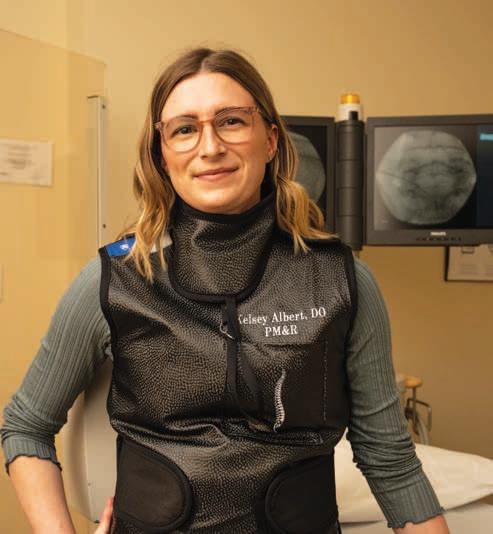
Dr. J. Fenton & Dr. K. Albert 321 Main St, Winooski, VT (802) 859-0000
VermontRegenerativeMedicine.com
Regenerative Interventional Orthopedic Medicine


A takeout-only chicken pie supper will be held Saturday, Oct. 14, at the Williston Federated Church, 44 North Williston Road, Williston.
The meal includes chicken pie and biscuit, squash, mashed potatoes, coleslaw, cranberry sauce and either apple or pumpkin pie.
Tickets are $15 for adults; children $8. Pick up times are staggered starting at 4:15 p.m. Just drive into the parking lot and an attendant will take your name and payment and retrieve your meals.
Call 862-7400 to make a reservation.
the University of Vermont Honors College in 2016 and has recently begun a fellowship at Akron Children’s Hospital.
Join local Vermont nonfiction author Marilyn Webb Neagley for a discussion about her newest book, “Attic of Dreams, a memoir,” at the Charlotte Senior Center on Thursday, Sept. 28, 7 p.m.
Neagley has spent most of her life in Shelburne where she now resides with her husband, Mark.

noon and are available for anyone 60 or older. Suggested donation is $5.
The menu is chicken cacciatore, wheat rotini pasta, peas and carrots, wheat bread, pumpkin cookie and milk.
To order a meal contact Kathleen at agewellstcath@gmail.com or 802-503-1107. Deadline to order is Wednesday, Oct 4. If this is a first-time order, provide your name, address, phone number and date of birth.
COURTESY PHOTO Borderlands, the annual outdoor performance event along a forest trail at Shelburne Farms, presents “Bravely Ever Onward, on Sundays in October. Also this year, a nighttime presentation of “Bravely Ever Onward” as a sound and light show will be held on Saturday evenings, Sept. 30 and Oct. 14 and 21. This performance shapeshifts familiar folk and fairy tales to gather wisdom for a generation experiencing loss. Inherited stories give us the navigational stars for young to find their path. What might we discover from the wise elders, the magician, the nightingale, the ravens, the mermaid, Baba Yaga or the Frog Prince? All proceeds support Treewild, Enchantment Camps and Shelburne Farms programs for children. More at treewild.org.
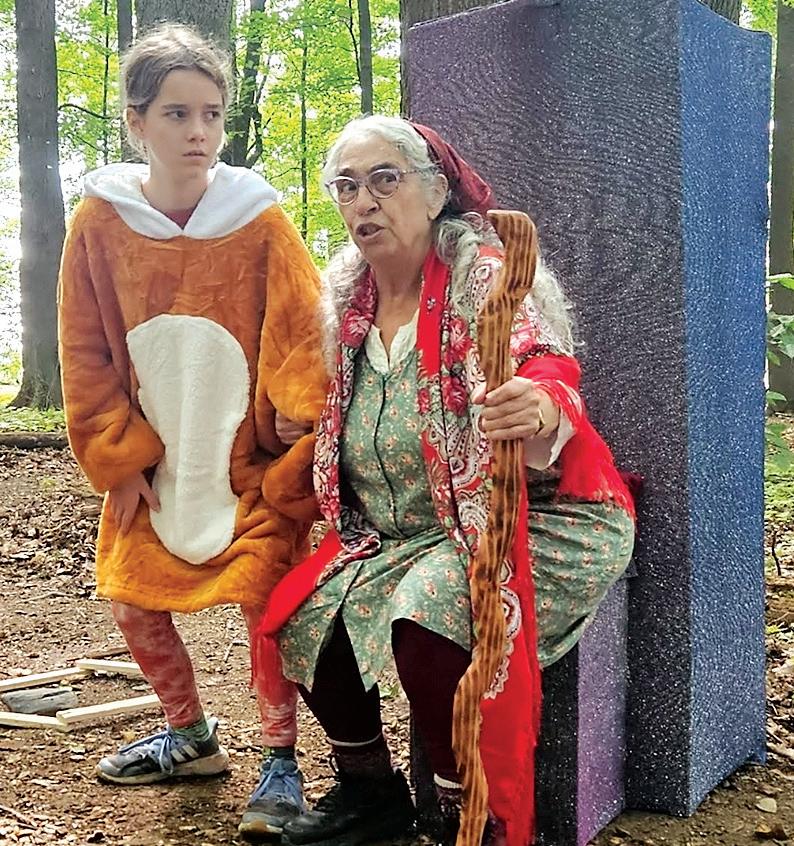
Jordan Fondacaro Weith was awarded her doctorate in clinical psychology from Kent State University, with a specialization in children and adolescence in August.
Weith, who grew up in Charlotte and is a graduate of Charlotte Central School and Champlain Valley Union High School, graduated Phi Betta Kappa from
Starting her career as an architectural interior designer, she veered toward environmental stewardship and became president of Shelburne Farms. She has been a commentator for Vermont Public and has written essays for her local newspaper.
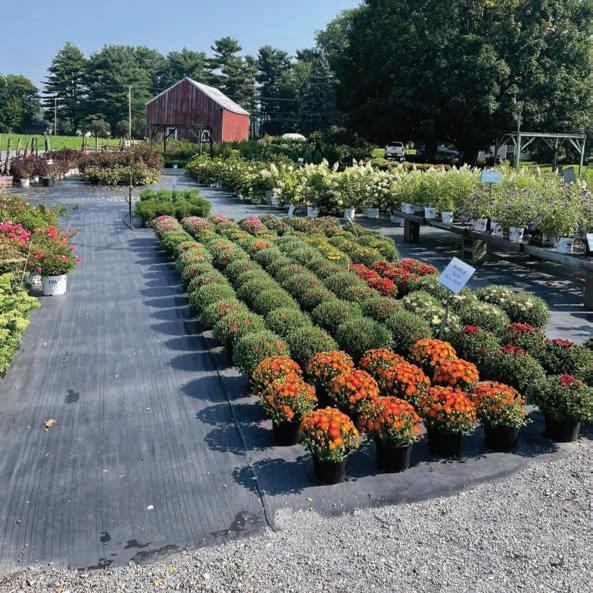
She previously wrote “Walking through the Seasons.” Co-sponsored by the Charlotte Library. Free, but registration recommended at 802-425-6345 or charlotteseniorcenter.org.
Age Well and St. Catherine’s of Siena Parish in Shelburne are teaming up to provide a meal to go for anyone age 60 and older on Tuesday, Oct. 10
The meal will be available for pick up in the parking lot at 72 Church St. from 11 a.m. until
If you haven’t yet filled out a congregate meal registration form, bring a completed registration form with you or send one to: Age Well; 875 Roosevelt Highway, Ste. 210, Colchester VT 05446. Forms will be available at meal pick up.
Learn about restaurant tickets to dine at participating restaurants at agewellvt.org.
The Age Well meal pickup for Thursday, Sept. 28, is from 10-11 a.m., Charlotte Senior Center, 212 Ferry Road, and features roast pork with gravy, boiled potatoes with parsley, butternut squash, wheat bread and butter, cookie bar with dates and Craisins and milk.
You must have pre-registered by the prior Monday at 802-4256345 or meals@charlotte

See COMMUNITY NOTES on page 9

One of just 10 schools nationally, Hinesburg Community School was picked to partner with the national education nonprofit organization, Transcend, as part of its Rural Schools Design Community.
The 10-month program helps school administrators and faculty to reimagine their school models to better serve students and families.
At the start of the program, each school community identifies a core team. Teams work locally to enlist the broader community in shaping the vision for their reimagined school.
Throughout the 10 months, the groups will generate a community-led school

continued from page 8
seniorcentervt.org
The meal on Thursday, Oct. 5 features baked meatloaf, mashed potatoes, mixed vegetables, wheat roll, sugar date cookie and milk.
The meal on Thursday, Oct. 12 features chicken cacciatore, wheat rotini pasta, peas and carrots, wheat bread, pumpkin cookie and milk.
The meal on Thursday, Oct. 19 features pork cutlet with peppers and onions in sauce, mashed cauliflower, beets, wheat roll, applesauce and milk.

The suggested donation is $5. Check the website for last-minute cancellations at charlotteseniorcentervt.org.


UVM Extension holds two agritourism webinars
University of Vermont Extension is hosting two free webinars for agritourism operators in October.
“Legislation to Support Agritourism in the United States” will be held via Zoom
process to achieve equitable results for all students, try to understand the skills and mindsets needed for young people to thrive in and transform the world, and learn how to ensure community aspirations and needs are reflected.
The Rural Schools Design Community is funded through a grant. Transcend is a national nonprofit that supports school communities to create and spread extraordinary, equitable learning environments.
The organization was founded on a belief that we must reimagine schooling, using a community-driven approach, so all children can realize their infinite potential.

on Wednesday, Oct. 4, at 1 p.m. U.S. Rep. Jennifer Wexton from Virginia and other legislative leaders will present information about the purpose and intent of the bipartisan Agritourism Act, designed to create an Office of Agritourism in the U.S. Department of Agriculture.
The office will represent the interests of agritourism enterprises and consolidate federal resources, such as loans, grants and broadband connectivity programs, to sustain these businesses.

To register, go to go.uvm.edu/legislation.
The following Wednesday, on Oct. 11, “Growing the Global Agritourism Network: Findings from Evaluations of Webinars and Conferences,” will begin at 10 a.m. This Zoom session includes an update on the Global Agritourism Network, which was established earlier this year to enhance the capacity of agritourism worldwide.
Register at go.uvm.edu/growing-agtourism.
The University of New England’s Corinna Hobbs of Hinesburg has been named the Commonwealth Coast Conference women’s cross-country runner of the week for the week ending Sept. 10, and rookie of the week. Hobbs placed second at the university’s Ouellette Invitational by 23 seconds with a time of 22:09, assisting her team to a second-place finish in the meet.
The Champlain Valley girls’ cross-country team took the top spot in the Manchester Invitational on Saturday.
Alice Kredell came in second overall to pace the Redhawks, while teammate Estella Laird was third. Lydia Donahue came in ninth place and Charlotte Crum was 14th. Audrey Neilson finished in 20th to round out the top five CVU runners.
For the boys, the Redhawks came in ninth place overall. Daniel was the first CVU runner across the finish line in 17th. Owen Deale was 32nd, Charles Garavelli was 50th and Kody Gutterman was 70th.
The boys traveled to the Newport Country Club on Thursday, coming in second in the North Country Invitational.
Cooper Guerriere was the top finisher for the Redhawks with a 78, Jack Bryan finished with a 79
and Camden Ayer had an 80. Jake Strobeck finished out the scoring with an 81.
Champlain Valley 2, St. Johnsbury 1 (2OT): Luke Sampson delivered the game winner in the second overtime period and Champlain Valley beat St. Johnsbury 2-1 on Saturday, Sept. 23.
Sampson’s winner came on a penalty kick in the fourth minute of the second overtime. Ziggy Babbott stopped seven shots in goal.
With the win, the Redhawks move to 5-1.
Champlain Valley 4, Burlington 0: The field hockey team moved to 4-1 after beating Burlington on Friday, Sept. 22.

Bibi Frechette tallied twice to pace the Redhawks, while Sophie Maddie and Lonne Kilkman each chipped in a goal.
Sophie Comeau got the win.
Champlain Valley 3, Burlington 0: The girls’ volleyball
team swept Burlington in straight sets on Thursday, Sept. 21.
The Redhawks won the first set 25-9, followed by a 26-24 second set and wrapped up the win with a 25-12 victory in the third.
Football
Champlain Valley 54, St. Johnsbury 7: The Champlain Valley football team raced out to a 40-7 lead in the first half and
did not look back in a win over St. Johnsbury Saturday.
Quarterback Ollie Cheer threw for 129 yard and four touchdowns, Anderson McEnaney had 25-yard rushing TD and returned a kick for a score. Brian Rutherford had two touchdown catches, while Billy Bates and Nolan Walpole each added a rushing touchdown.
Michael Dunbar and Dylan Frere each had an interception
and the Redhawks recovered three fumbles.
The win moved CVU to 3-1.
Girls’ soccer
Champlain Valley 1, South Burlington 0: Reese Kingsbury scored the lone goal to lift the girls to a win over South Burlington Friday.

Anya Johnson got the shutout with four saves
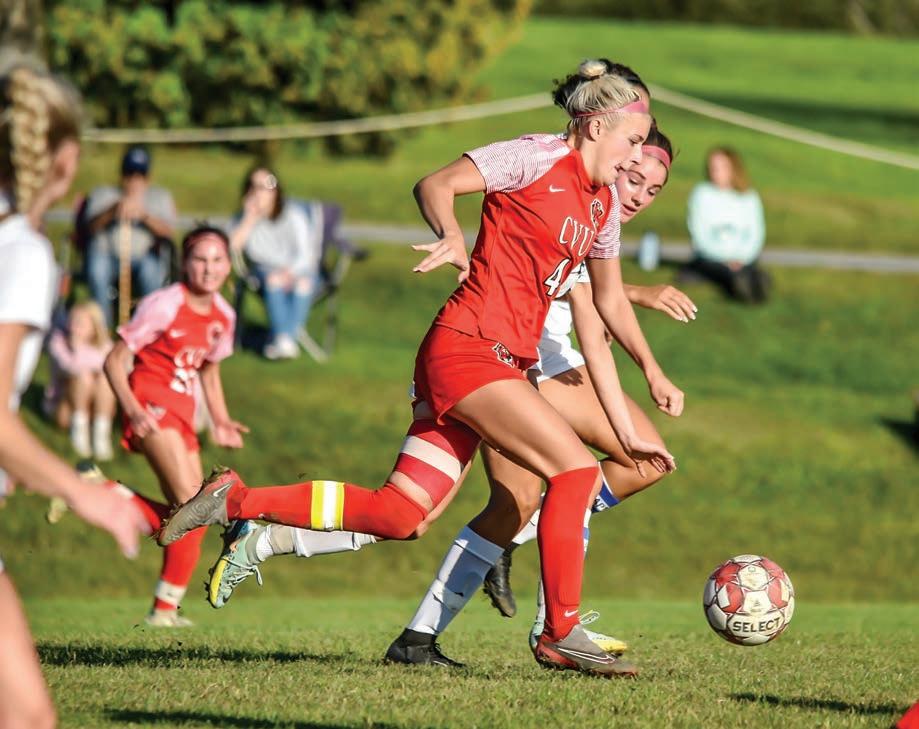

















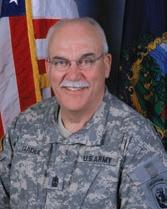



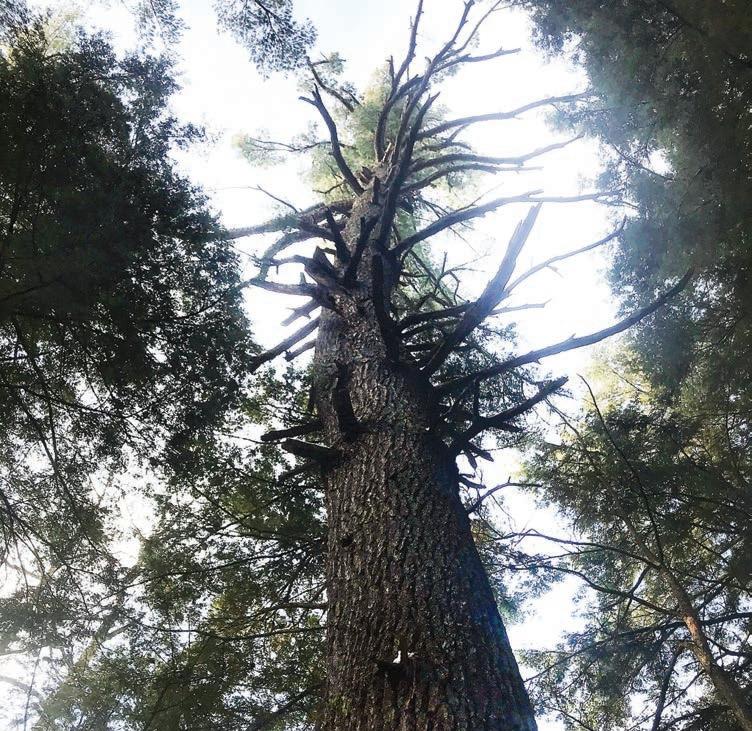

On a highly altered landscape, the idea of an old-growth forest is captivating to many. But what are old-growth forests? Why do they matter?
Some would say that the only true old-growth forests are primary forests — the tiny fraction that has never been extensively altered by humans or by humans of European descent. Others would say that an old-growth forest is any forest that is old, one that has escaped extensive disturbance for a long period of time, usually at least several centuries.
Others would say that a forest becomes old-growth when it attains late-successional characteristics, the suite of traits common to many older forests. These characteristics include multiple generations of trees — what I call multi-generationality — some big, old trees and lots of dead wood on the forest floor.
The rareness and uniqueness of oldgrowth forests has convinced some people that the best thing for our forests is just to leave them alone. Unfortunately, this is not so.
By any definition, most people have never seen an old-growth forest in Vermont, or anywhere in eastern North America. Unless you specifically seek out one of our few remnant old-growth forests, a walk in Vermont’s woods will carry you through an area that was a field or a clearcut within the last 150 years, and probably as recently as the 1960s.
Most of Vermont’s forests are just 60-100 years old — just at the beginning of their centuries or millennia-long journey toward old-growth. While old-growth forests once covered more than 90 percent of Vermont, today the number is closer to 0.1 percent — perhaps one thousand acres in total.
What are old-growth forests like? While they are defined by their irregularity and their variability, which make it difficult to generalize, old-growth forests — whether they are primary or just old — often feature those late-successional characteristics. While the most obvious of these is big, old trees — but not a lot, often just 10-12 per acre — old-growth is equally characterized by multi-generationality, by tons of dead wood on the forest floor, by a canopy filled with gaps and by deep, well-developed soils. Interestingly, while many people imagine that old-growth forests are peaceful and easy to appreciate, these qualities make them seem incredibly messy, chaotic, even jarring.
From an ecological perspective, old-growth forests are not just valuable because they’re old. They’re valuable because of these characteristics. On a land-
scape that was once dominated by old growth, the characteristics mentioned above are the conditions to which our native flora and fauna have adapted for thousands of years. Each of these characteristics supports vital natural processes and provides important habitats for wildlife, and all are woefully underrepresented on our modern landscape. The rareness and uniqueness of old-growth forests has convinced some people that the best thing for our forests is just to leave them alone. Unfortunately, this is not so. While we should certainly protect all existing old growth forests and set aside some unmanaged reserves, we need to acknowledge that our forests are facing an apocalyptic array of threats and stressors: they have been cleared and exploited; have lost native species and had non-natives introduced; and are simultaneously navigating a climate crisis, a biodiversity crisis and a mass extinction event. Many, if not most, of our forests have been altered to an extent where they will likely never become old growth without our help. Of the forests that may someday become old growth on their own, this process will likely take two or three centuries, leaving our planet and our biodiversity to suffer in the meantime.
While we say Not in My Backyard to local forest management, forests — including old-growth forests — will be exploited across the world to feed the need for resources, forcing peoples and ecosystems elsewhere to bear the cost of our consumption. As we pretend that the beauty and the importance of old growth means that we should leave every forest unmanaged, forests and the biological communities that they support will continue to suffer without our help.
To me, old-growth forests are a call to action. At a time when old-growth is more needed than ever before, we can use forest management to create old-growth characteristics, and the myriad habitats and benefits that they provide, in decades rather than centuries. We can do so while protecting biodiversity, sequestering and storing carbon, producing local, renewable resourcesand supporting a vibrant and just local and global economy.
To me, this is a far greater tribute to old growth than leaving every forest alone.
HINESBURG
continued from page 1
would cost anywhere from $18 to $20 million.
Of particular interest for the Windy Ridge project is its possible Act 250 exemption. Housing projects in Neighborhood Development Areas would be exempt from Act 250 permitting if 20 percent or more of their unit mix is considered affordable.
Miranda Lescaze, the director of real estate development with the Champlain Housing Trust, said the project would be subject to the maximum Act 250 fee due to its size, totaling $165,000, in addition to costs associated with the project’s design by professionals.
“Being exempt from Act 250 would save the project likely $200,000 in direct project costs,” she said. “Construction costs are sky high right now and the savings of not going through the Act 250 process really enables a project like this that would create affordable homes to move forward.”
But the process of moving the application through town hall was not unanimous. Town planning commission members, which first approved the application, did so after a 3-1 vote, with two members undecided and three absent during the meeting.
The Neighborhood Designation Area map, first presented to the selectboard earlier this month, was redrawn to exclude the area around Hinesburg Center II. Some of the planning commission members were uncomfortable having any of the flood hazard area included in
BAREHAM
continued from page 1
split between about 11 to 12 facilities across five or six counties, and I handled a lot of the administrative legwork that went along with that. I conducted trainings, performed audits and made sure that we were abiding by all state and regional standards.”
With a background in public administration from the State University of New York, Brockport, he said he began to work in the park system mostly due to his interest in conservation, but most of his focused coursework had more to do with land use regulations.

“I really loved natural resource conservation and wildlife conservation, and a big aspect of that is land use law zoning,” he said. “I focused a lot of my coursework on that and took classes in land conservation law, the use of conservation easements and property law. We looked specifically at Act 250 in Vermont, but then also zoning ordinances and enabling statutes for surrounding states, particularly in New Hampshire.”
the zone.
“The concerns for most commissioners that were not in favor were about the Act 250 exemption,” Weinhagen said.
Skeptics of the application said that the designation would possibly incentivize developers to incorporate 20 percent affordable housing units into their mix to avoid Act 250 hearings.
“Which you are all assuming is a positive,” Meg Handler, a member of the town’s conservation commission, told the selectboard. “But that becomes the vehicle for them to avoid Act 250.”
“The consequences of this are huge and unforeseen. The conservation commission does not support removing the entire village growth area from Act 250,” she said. “Act 250 was put in place to help us as a community, and you are giving it away for the sake of a few hundred thousand dollars on an $18 million project.”
While the town’s village area has been targeted for housing development for decades, there are underlying concerns that the town is concentrating development in an area with floodplains just to the west.
The village area is directly adjacent to the LaPlatte River on the east side of town — the Haystack and Hinesburg Center II properties are just to the east of the river — and south of the Patrick Brook. Data from the state shows that much of the area on the west side of the village is in a Federal Emer-
gency Management Administration special flood hazard area.
“We have not fully appreciated that amount of impervious surface that’s coming and contributing more water to Patrick Brook that comes down from all the Richmond Road development,” Andrea Morgante, a Hinesburg resident and member of the Hinesburg Land Trust, said.
The Hinesburg Center II project, which would create 21 new lots and include 73 new homes, is currently in the Act 250 process over flooding concerns.
In letters to the Act 250 commission overseeing the review, officials with Vermont’s Agency of Natural Resources said the project “creates an increased risk of flooding on the project property before any impacts of climate change may be considered, as well as resulting in the loss of floodplain function in the Patrick Brook and LaPlatte floodplains which impacts the floodplain’s ability to mitigate future flooding.”
Those opposed to the designation, including Handler, have pointed to Hinesburg Center II, currently under review in environmental court, as “an example of the failure” of the town’s review
process to “protect our quality of life, ecological infrastructure that stands as an example that I think we need to keep in mind.”
Selectboard members raised questions over whether the designation could be applied to just the Windy Ridge project.
Weinhagen said that was feasible, but that “the implications are that all the other benefits of the NDA program — which seem to be playing second fiddle to this conversation about the act 250 exemption — would only then apply for the windy ridge project.”
Ultimately, selectboard
members pointed to the added benefits beyond Act 250 exemptions — and Windy Ridge’s 60 affordable homes — as enough to approve the designation.
“Windy Ridge has 60 affordable homes. It’s an enormous amount of money that it’s going to save them so they can move forward and put toward another project in another town,” selectboard member Maggie Gordon said. “This board a couple of years ago said that affordable housing is a priority, and this just seems almost unconscionable not to do it.”
Selectboard chair Merrily Lovell noted that with millions of dollars expected to be spent on a new wastewater treatment plant, “if we can have more people carrying that burden, it’s going to help us. Regardless of how I might feel personally, I think it’s in the town’s best interest to do something that’s going to help the developers to develop more residential housing.”
PUBLIC HEARING
Bareham said that although this will be his first major leap into local government, the bulk of his studies were centered around municipal work.
“We always talked about how a good basis of legal understanding is important in municipal government, which is ultimately why I decided to go to law school but the idea of working in municipal government was always there,” he said.
Although there were close to
18 applications in total submitted for the position, Lewis Mudge, chair of the search committee and member of the selectboard, said Bareham jumped out to the group from the start.
“His work in pretty complex bureaucracy within the park system and a real dedication to conservation and open spaces align with the sort of ethos that we think helps drive Charlotte,” he said.
Current town administrator Dean Bloch will remain on the job until Nov. 30 to help in the training process.
Town officials are planning a going away and welcoming celebration for both Bareham and Bloch that will be announced in the coming weeks.
“I’m most excited for really trying to get to understand the community more,” Bareham said. “I think that I can bring a lot to the table here. But I think that’s for nothing if I don’t really understand the community and the issues that they have and their interests.”
Hinesburg Development Review Board
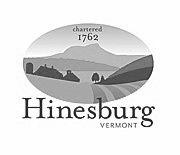
Tuesday, January 17, 2023 7:00 pm
On September 20, 2023, the Selectboard of the Town of Hinesburg, Vermont, adopted amendments to the existing “Municipal Wastewater Allocation Ordinance” and “Municipal Water Use Ordinance” pursuant to 24 V.S.A. §3625. This notice is published pursuant to 24 V.S.A. § 1972 to inform the public of these amendments and of the citizens’ right to petition for a vote to disapprove these amendments.
Jeremy Hester - Conditional use review for expansion of a non-complying structure (deck) on a 0.24-acre property located at 77 Shadow Lane, in the Rural Residential 1 zoning district.
The meeting will be both in person and remote. See meeting agenda on town website with details on how to participate.
The full text of the Ordinances may be examined at the Town Clerk’s office at 10632 Route 116, Hinesburg, VT 05461 and may be examined during regular office hours.
Title 24 V.S.A. § 1973 grants citizens the right to petition for a vote at a special or annual Town Meeting to disapprove ordinance amendments adopted by the Selectboard. To exercise this right, citizens must present to the Selectboard or the Town Clerk a petition for a vote on the question of disapproving the amendments signed by not less than five percent (5%) of the Town’s qualified voters. The petition must be presented within forty-four (44) days following the date of the adoption of the amendments. Unless a petition requesting a vote is filed pursuant to 24 V.S.A. § 1973, the amended “[insert name of ordinance]” shall become effective sixty (60) days from the date of said adoption.
Additional information pertaining to this Ordinance may be obtained by contacting Todd Odit, Town Manager at todit@ hinesburg.org, or by calling 802-482-4206 during regular office hours.
“Act 250 was put in place to help us as a community, and you are giving it away for the sake of a few hundred thousand dollars on an $18 million project.”
— Meg Handler
continued from page 2
The week-long bait drop is a coopera tive effort between Vermont and the U.S. Department of Agriculture Wildlife Services to stop the spread of the potentially fatal disease.
Rabies is a deadly viral disease of the brain that infects mammals. It is most often seen in raccoons, skunks, foxes, and bats, but unvaccinated pets and livestock can also get rabies.The virus is spread through the bite of an infected animal or contact with its
continued from page 2
The week-long bait drop is a coopera tive effort between Vermont and the U.S. Department of Agriculture Wildlife Services to stop the spread of the potentially fatal disease.
Rabies is a deadly viral disease of the brain that infects mammals. It is most often seen in raccoons, skunks, foxes, and bats, but unvaccinated pets and livestock can also get rabies.The virus is spread through the bite of an infected animal or contact with its
• Basement Waterproo ng • Crawl Space Repair • Sump Pump Systems • Foundation Repair • Egress Windows
Hyper Relic Sports Cards
SHELBURNE continued Construction 1111-855-DRY-TIME • www.northernbasements.com

Build / Remodel
Roofing Siding

Renovations
Painting Decks
802-343-4820
www.pleasantvalleyvt.com
Funeral
CORBIN
FUNERAL HOME & CREMATION SERVICES






SHELBURNE FUNERAL CHAPEL
E L E L Brush Hogging Will rototill your garden or brush hog your elds. Call Frenchy 324-5796 or 985-5379 324-5796 or 324-0558 Acupuncture Bottle Redemption Tenney’s Bottle Redemption bulk bottle returns & bottle drives 76 Jackson Hill Road • Charlotte (at Spear and Hinesburg-Charlotte Rd) 802-425-2180 10 Flavors of Milkshakes Snack Bar • Creamee Window • Hard Ice Cream Propane Fill Station Mon.-Sat. 9am-6pm • Closed Sun. Acupuncture & Massage Champlainwellness.com 802-989-9031 527 Ferry Road - Charlotte, VT Felipe Toro, LAc Empowering people to achieve their best health and wellbeing Siding/Remodeling service directory To advertise in the service directory email: Advertising@thecitizenvt.com or call 985-3091 4/29/2019 3.5 x 2 AD for Shelburne News & The Citizen 24 Consecutive Weeks $18.00/week for both papers $432.00 BEAGLE BUILDERS, LLC Monkton, VT beaglebuilders@gmavt.net 802-453-4340 CALLUS! 802-355-0807 Remodeling & Additions ALL TYPES OF SIDING Vinyl/Wood/Composite Windows & Doors • Decks & Porches Kitchens & Bathrooms Sunrooms & Garages Brian Bittner • 802-489-5210 • info@bittnerantiques.com Showroom at 2997 Shelburne Rd • Shelburne Open Wed-Fri, with walk-ins to sell every Thursday. www.bittnerantiques.com ANTIQUES WANTED Decluttering? Downsizing? We can help you discover, learn about and sell: WATCHES • JEWELRY • COINS • SILVER • ARTWORK Painting TONY BRICE PAINTING, LLC Free Estimates Interior & Exterior 802.777.8771 Scheduling 2023-2024 Interior Painting TO ALL OF OUR CLIENTS, THANK YOU!

Shelburne display lead dors from creemees. from Spring Cleanup & Mulch Lawn Maintenance Landscape Design Stonework & Planting Mini Excavation 802-343-4820 www.pleasantvalleyvt.com

Family owned and operated since 1921

Pre-planning services available 209 Falls Road, Shelburne, VT (802) 985-3370


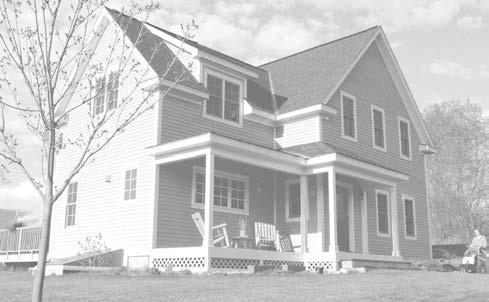

Bob & Jessica Trautwine Cell/Txt: 802-233-1451 • O ce: 802-497-1681 Hyperreliccards@gmail.com • hyperrelic.com

ANSWERS FROM THIS ISSUE




September 28, 2023

A lot of Vermonters are noticing that their crabapples and apples, in addition to many other deciduous trees, have dropped many of their leaves well before the first autumn frost.
This has been a common occurrence for the past few years in many parts of the state depending on the microclimate of the area. The cause is typically stress-related. The good news is that these early defoliated trees usually will look fine the next spring.
The emerging leaves and blossoms of many trees were damaged by the low temperatures in the third week of May. Although the trees have recovered and new leaves replaced those that were damaged, the energy required to do that caused stress on the tree.
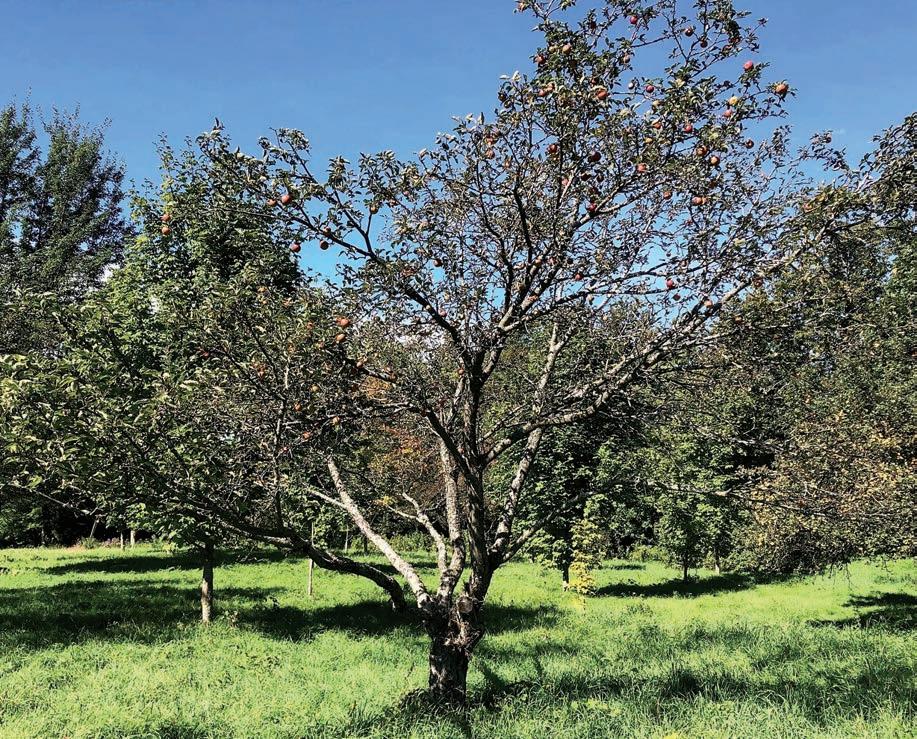
Vermont also experienced a very rainy summer. Malus, or crabapple, is susceptible to a wide variety of foliar fungal diseases, and all these fungi like wet weather. Diseased leaves tend to drop earlier in the season than healthy leaves, and these fungal leafspot diseases are a big contributing factor to the early leaf drop.
Apple scab is the primary

disease that will infect fruit and leaves, causing olive brown spots on the foliage. Another contributor to diseased leaves is cedar apple rust, a fungus that requires both a crabapple host and a juniper host to complete its lifecycle. This rust disease causes bright yellow leaf spots on the apple or crabapple host.
If you notice early leaf drop in your apples or crabapples, check to make sure there is a good bud set on the tree for next year. These are the dormant buds that will start to grow next May.
Scratch the bark lightly to make sure you see green healthy tissue under the bark. Both indicate that the tree is ready for next spring and is still alive despite the leaf drop.
To improve the vigor of the tree and to minimize fungal diseases next year, rake and destroy fallen leaves this autumn. If raking is too much work, mow over the leaves several times to encourage them to break down quicker. Prune the tree this winter when it is dormant to open it up to air and light.